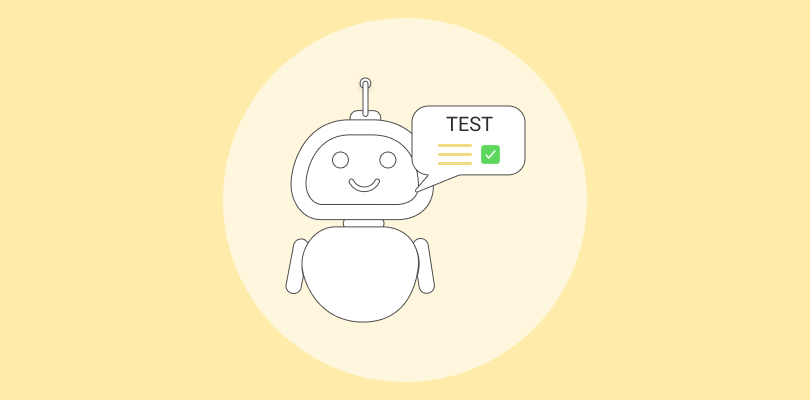Imagine a world where your customers never have to wait for assistance from a human agent. They ask a question, and instantly, an AI-powered assistant responds with the exact solution they need.
This is what a knowledge base chatbot does. It uses your existing content, such as FAQs, guides, and manuals to deliver precise, 24/7 support without overwhelming your team.
For growing businesses, it’s not just about convenience; it’s about scaling and automating customer service while maintaining quality.
In this blog, I’ll share what a knowledge base chatbot is, why it’s reshaping customer support, and how you can build one that fits perfectly into your business.
What Is a Knowledge Base Chatbot?

A knowledge base chatbot is a powerful virtual assistant that provides instant, accurate answers by pulling information directly from your company’s knowledge base.
Instead of relying on pre-set scripts, it uses your existing help articles, FAQs, and documentation to respond to customer or employee queries.
It’s designed to make self-service smarter and faster—whether it’s helping a customer troubleshoot an issue, guiding a new employee through onboarding, or answering product-related questions.
Unlike traditional chatbots, a knowledge base chatbot continuously learns from updated content, ensuring responses stay accurate, consistent, and available 24/7 without human intervention.
Benefits of Using Knowledge Base Chatbots
When customers want answers fast, a knowledge base chatbot does more than just automate replies—it transforms how your team delivers support. Here’s why businesses are adopting them so quickly:
1. Instant, Accurate Responses
A knowledge base chatbot gives customers quick, reliable answers by pulling information directly from your existing content. Whether it’s FAQs, policies, or product guides, it ensures users never have to wait or search endlessly. This level of instant accuracy not only improves satisfaction but also builds trust in your brand’s ability to deliver seamless, on-demand support.
2. Reduced Support Workload
When repetitive questions dominate your inbox, a chatbot becomes your team’s silent ally. It handles the bulk of basic queries automatically, freeing human agents to focus on complex issues that need real problem-solving. This balance helps reduce burnout, optimize response times, and ensure every support hour is spent where it truly adds value.
3. Consistent Customer Experience
Human agents can interpret questions differently, but a knowledge base chatbot doesn’t. It gives uniform, verified responses pulled from your centralized content, keeping messaging consistent across all channels.
Whether customers ask through chat, email, or social media, they’ll always get the same accurate information, reinforcing your brand’s reliability and maintaining professional consistency in every interaction.
Pro Tip: Before deploying your chatbot, create a response style guide that defines tone, phrasing, and terminology. This keeps communication on-brand and consistent.
4. Better Content Utilization
Most companies spend hours creating help articles that few people read. A chatbot changes that by turning your knowledge base into a conversational assistant. It guides customers directly to the right article or snippet, increasing engagement and visibility for your documentation.
In short, it ensures the effort you invest in content creation pays off every day.
5. Actionable Insights

Every conversation with a knowledge base chatbot reveals what your customers truly need. By analyzing chat data, you can spot gaps in your content, identify trending questions, and even predict customer pain points. These insights help you refine both your chatbot and your documentation, making support smarter and more proactive over time.
Pro Tip: Review chatbot analytics weekly and tag unanswered questions. Over time, this builds a roadmap for improving both your knowledge base and user experience.
How to Build a Knowledge Base Chatbot in 2025
Building a custom knowledge base chatbot might sound technical, but it’s actually pretty simple when you have the right tools. To show you how it works, I’ll use ProProfs Chat as an example.
It lets you create a chatbot, connect it with your knowledge base, and start automating customer support—all without any coding.
Step 1: Open your ProProfs Chat dashboard, navigate to the Bots section, and select Edit to get started.

Step 2: Choose the step where you want to enable bot training.

Step 3: Turn on the “Would you like the user to respond?” option using the toggle switch, choose “Custom training,” and then click Save.

Step 4: Set up the training panel.
- Select Knowledge Base or Custom End Point from the dropdown.
- Enter your knowledge base URL.
- Click Start Training to begin.

Here’s how your bot replies to a visitor’s question in the chat window.

Best Practices for Building Knowledge Base Chatbots
A knowledge base chatbot can be your smartest support teammate—if built right. It’s not just about connecting AI to your content but designing a system that listens, learns, and improves over time.
To build AI chatbot with custom knowledge base, follow these best practices for fast, accurate, and human-like support experiences.
1. Start with High-Quality, Well-Structured Content
Your chatbot is only as smart as your knowledge base. Make sure your articles are clear, updated, and easy to interpret. Use consistent formatting, concise titles, and searchable keywords so the AI can pull the right information every time.
2. Train Your Chatbot with Real Conversations
Use actual customer queries to teach your chatbot how people phrase their questions. Incorporate variations, slang, and common typos to make the bot sound natural and understand context better. This ensures accuracy and prevents frustrating “I don’t understand” moments.
3. Create a Smooth Handoff to Human Agents
Even the best AI has limits. When the chatbot can’t resolve an issue, make sure it transitions seamlessly to a human agent. Include context from the chat so the agent doesn’t ask repetitive questions. This keeps the experience effortless for customers.
Watch this video to see how AI chatbots and human agents team up to delight customers.
4. Test, Monitor, and Improve Continuously
A great chatbot isn’t built once—it evolves. Regularly review chat logs, missed questions, and user feedback to refine responses and update your knowledge base. Treat your chatbot like a living product that learns and improves with every interaction.
5. Personalize the Experience with Data and Tone
Customers appreciate relevance. Use data such as name, location, or past behavior to personalize responses. Keep the tone friendly yet professional so it feels like an extension of your brand voice. Personalization adds warmth to automation and builds long-term trust.
FREE. All Features. FOREVER!
Try our Forever FREE account with all premium features!
Make Self-Service Effortless with Knowledge Base Chatbots
Knowledge base chatbots provide customers with instant access to accurate information from your help center, reducing support workload and enhancing user experience. Understanding how to build AI chatbot with custom knowledge base is key to maximizing these benefits.
To get the best results, I always recommend keeping your knowledge base updated, training your chatbot with real interactions, and using insights from analytics to refine its responses.
I’ve found ProProfs Chat especially useful for this. Its AI-powered chatbot pulls details directly from your knowledge base, suggests helpful articles, and connects complex queries to live agents — all while keeping conversations fast and effortless.
FREE. All Features. FOREVER!
Try our Forever FREE account with all premium features!

 We'd love your feedback!
We'd love your feedback!
 Thanks for your feedback!
Thanks for your feedback!







